How to replace the gear case in a top-load washer
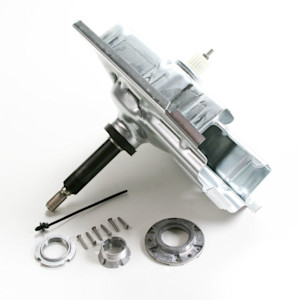
This step-by-step washer repair guide explains how to replace the washer gear case in a common style of top-load washing machine.
The washer gear case:
Drives the impeller that agitates the clothes during the wash cycle.
Rotates the spin basket in the spin portion of the cycle.
Shifts the drive system between the agitation and spin modes.
If the gear case doesn't drive the impeller or spin basket properly, replace it with the manufacturer-approved washer part.
Use the steps in this guide to replace the washer gear case in Kenmore, Whirlpool, Maytag and Amana top-load washing machines.
This video shows how to replace the gear case in a top-load washing machine.
Instructions
- 01.
Shut off the electricity and water
Unplug the power cord from the wall outlet. Turn off the water supply valves for the washer.
Wear work gloves to protect your hands. Have someone help you move the washer away from the wall.
- 02.
Disconnect the hoses
Label the hot and cold hoses. Using channel lock pliers loosen and remove both hoses. Expect some water to pour out. Pull the drain hose out of the standpipe behind the washer. Expect some water to pour out.
Tip: Wipe up water spills with a towel to prevent slipping.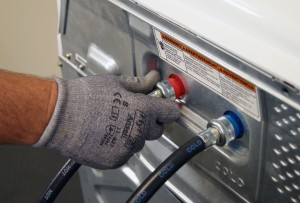
PHOTO: Disconnect the hoses from the back of the washer.
- 03.
Lift the top panel
Tape the lid shut so it doesn't flop open and damage the control console or hit your arms as you work.
Remove the screws that hold the top hinge bracket on the back of the washer.
Remove the screw from the wire cover and pull it off the washer. Lift the top panel and prop it against the wall behind the washer.

PHOTO: Tape the lid shut.
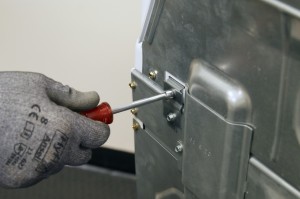
PHOTO: Remove the top screws from the hinges.

PHOTO: Remove the screw from the wire cover.
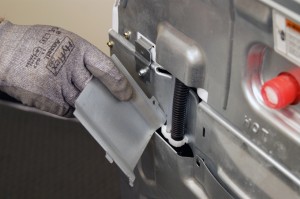
PHOTO: Remove the wire cover from the washer.
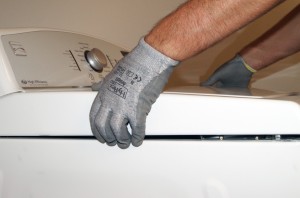
PHOTO: Move the top panel slightly forward and up.
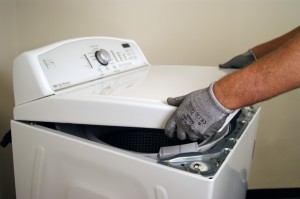
PHOTO: Push the top panel back to release it from the brackets.
- 04.
Remove the tub ring
Pull the bottom of the tub ring to release it from the locking tabs on the side of the outer plastic wash tub—use a slot screwdriver if necessary.
Pull the tub ring out of the washer.
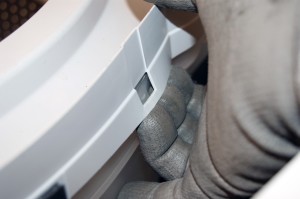
PHOTO: Release the tub ring locking tabs.
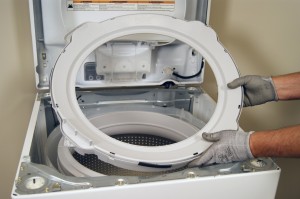
PHOTO: Remove the tub ring from the washer.
- 05.
Remove the impeller
Insert a slot screwdriver into the notch in the base of the plastic cap and pry the cap off the impeller.
Use a socket or wrench to remove the bolt that secures the impeller to the drive motor shaft.
Grasp the impeller firmly and pull it out of the washer.
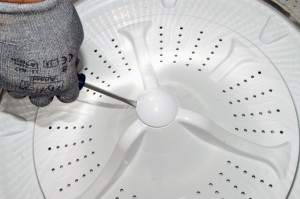
PHOTO: Pry the cap off the impeller.
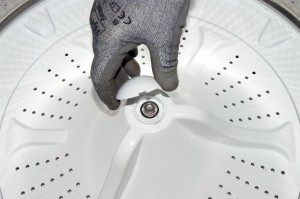
PHOTO: Remove the impeller cap.
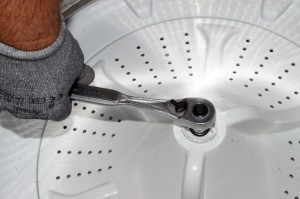
PHOTO: Loosen the bolt holding the impeller to the drive motor shaft.
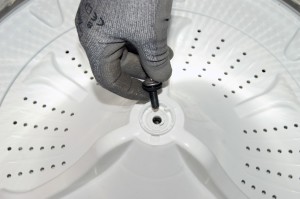
PHOTO: Remove the bolt holding the impeller to the drive motor shaft.
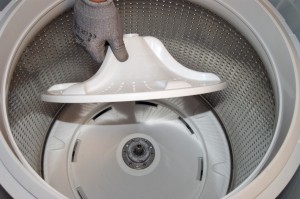
PHOTO: Remove the impeller from the washer.
- 06.
Remove the spin basket
Insert a slot screwdriver on the closed end of the retainer clip and pull outward to remove it.
Pull straight up on the spin basket to remove it from the washer tub.
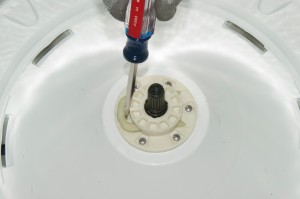
PHOTO: Insert a screwdriver on the retainer clip.
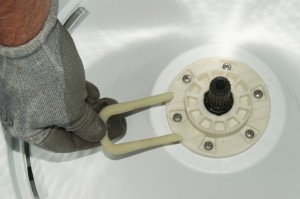
PHOTO: Remove the retainer clip.

PHOTO: Pull the spin basket out of the tub.
- 07.
Carefully lay the washer on its front panel
Lay cardboard or towels in front of the washer to protect the finish.
Carefully tilt the washer forward and lay it on its front.

PHOTO: Lay the washer down on its front panel.
- 08.
Remove the gear case
Remove the bolts that hold the plastic cover over the motor and drive components.
Pull the plastic cover off the washer and set it aside.
Release the locking tabs on the wire harness connection and pull the wire harness out of the connector on the shifter.
Disconnect the motor wire harness.
Pull the wire harness connector off the capacitor.
Release the wire harness retaining clips from the gear case housing.
Pull the wire harness out of the way.
Remove the bolts from the gear-case housing.
Pull the gear case out of the washer.
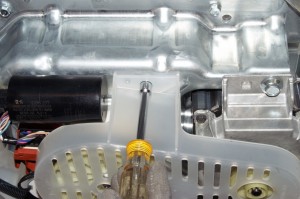
PHOTO: Remove the bolts holding the plastic cover over the motor.
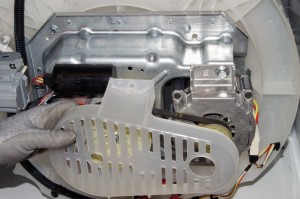
PHOTO: Remove the plastic motor cover.
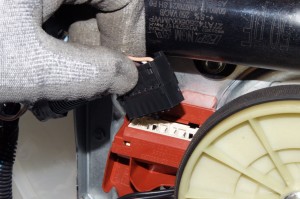
PHOTO: Remove the wire harness from the shifter.

PHOTO: Disconnect the motor wire harness.
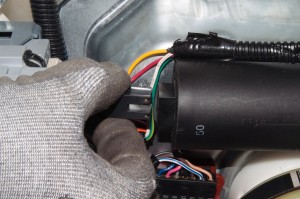
PHOTO: Remove the wire connector from the capacitor.
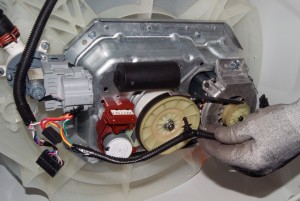
PHOTO: Release the wire harness retaining clips from the gear case housing.

PHOTO: Remove the gear case mounting bolts.
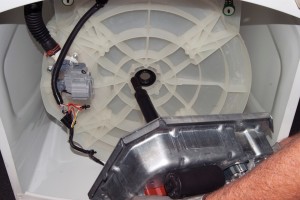
PHOTO: Pull the gear case from the washer.
- 09.
Install the new gear case
Transfer the motor, splutch, shifter, capacitor and belt to the new gear case.
Push the new gear case into the bottom of the washer tub.
Install the mounting bolts into the gear case and tighten them securely.
Reconnect the wiring connectors for the motor, capacitor and shifter.
Push the harness retainer clips into their original locations.
Remount the plastic motor cover using the two mounting bolts and tighten firmly.
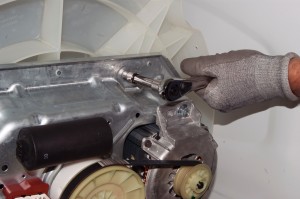
PHOTO: Tighten the gear case mounting bolts
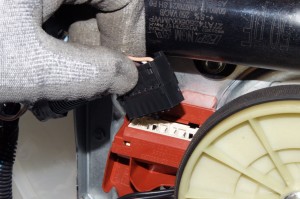
PHOTO: Reconnect the wiring connectors.
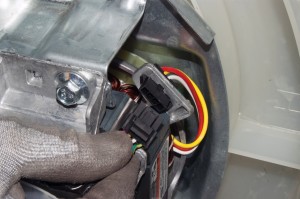
PHOTO: Reconnect the motor harness connector.
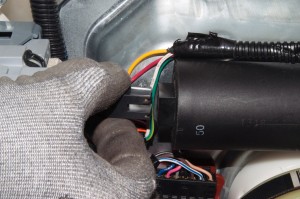
PHOTO: Reconnect the capacitor.
- 10.
Reinstall the spin basket
Set the washer upright.
Position the spin basket on the top of the shaft in the bottom of the tub and work the spin basket onto the shaft until it's completely seated on the shaft.
Position the retainer clip into the slotted area of the basket hub and slide it in until it locks into place.
Push the impeller on top of the drive motor shaft until it's fully seated.
Insert the bolt and tighten it firmly.
Snap the cap back onto the top of the impeller.
- 11.
Reinstall the tub ring
Position the tub ring on the top of the outer tub and push it down.
Push on the sections over the locking tabs so that the tabs snap into the locked position.
Lower the top panel on the washer until it locks down in place firmly.
Remove the tape holding the lid closed.
- 12.
Reinstall the screws
Insert the screws into the top of the hinges on the back of the control console and tighten firmly.
Place the tabs on the right side of the wire cover in the slots and then line up the holes on the left side and insert the mounting screw.
Tighten the mounting screw to secure the wire cover in place.
- 13.
Reinstall the fill hoses
Thread the fill hoses onto the correct connections on the back of the washer.
Tighten the connections firmly using channel lock pliers; don't overtighten, which could crack the plastic on the inlet valve.
- 14.
Restore the water and power
Turn on the water supply valves.
Plug the washer into the electrical outlet.
Return the washer to its original location.
- 15.
Calibrate the washer
With the washer shut off, the basket empty (no water or clothes) and the lid closed, enter the diagnostic mode:
Turn the control dial 1 complete rotation (360 degrees) counterclockwise.
Quickly (within about 6 seconds) turn the control dial 3 clicks clockwise, one click counterclockwise, and one more click clockwise.
All the green status lights blink when you successfully activate the diagnostic mode.
If the status lights don’t blink, turn the control dial one complete rotation counterclockwise to reset the control and then try again, this time turning the knob faster.
In the diagnostic mode, select the Calibration Cycle by turning the control dial 4 clicks clockwise. When the Rinse light turns on, press Start to begin the Calibration Cycle, which runs for 2 to 3 minutes.
When the Calibration Cycle ends, the lid unlocks and the washer shuts off.
Most common symptoms to help you fix your washers
Choose a symptom to see related washer repairs.
Main causes: clogged drain hose, house drain clogged, bad drain pump, water-level pressure switch failure, bad control b…
Main causes: worn agitator dogs, bad clutch, broken motor coupler, shifter assembly failure, broken door lock, suspensio…
Main causes: bad lid switch or door lock, bad timer or electronic control board, wiring failure, bad water inlet valve a…
Main causes: broken lid switch or lid lock, bad pressure switch, broken shifter assembly, faulty control system…
Main causes: unbalanced load, loose spanner nut, worn drive block, broken shock absorber or suspension spring, debris in…
Main causes: no water supply, bad water valves, water-level pressure switch failure, control system failure, bad door lo…
Main causes: lack of electrical power, wiring failure, bad power cord, electronic control board failure, bad user interf…
Main causes: leaky water inlet valve, faulty water-level pressure switch, bad electronic control board…
Main causes: water heater failure, bad water temperature switch, faulty control board, bad water valve, faulty water tem…
Repair guides for top-load washers
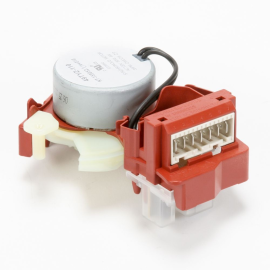
How to replace the shifter assembly in a top-load washer
The shifter motor switches the washer's drive motor between the agitate and spin modes. If your washer's basket won't bu…
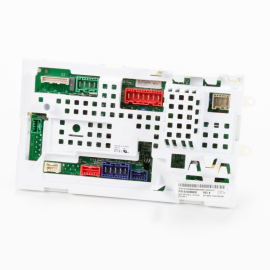
How to replace the electronic control board on a top-load washer
The electronic control board is a major component that orchestrates the washer's functions. These instructions explain h…
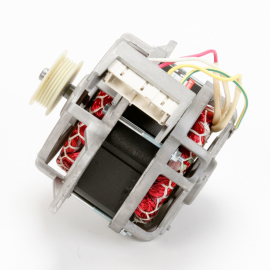
How to replace the drive motor in a top-load washer
The drive motor creates the rotation that turns the spin basket and agitator. If those components won't budge, replace t…
Effective articles & videos to help repair your washers
Use the advice and tips in these articles and videos to get the most out of your washer.
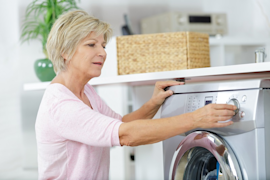
Find tips for using your washing machine efficiently to save energy and help reduce utility bills.…

Learn about all the convenient features on our Sears PartsDirect website that make your parts purchases easier.…

Get answers to frequently asked questions about Sears and Sears PartsDirect.…
